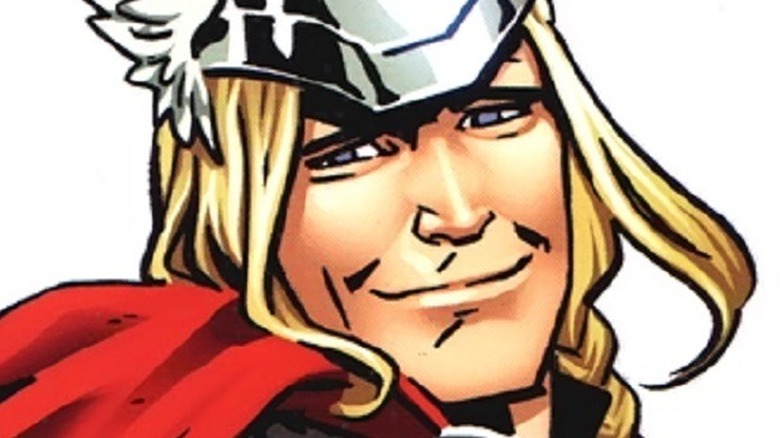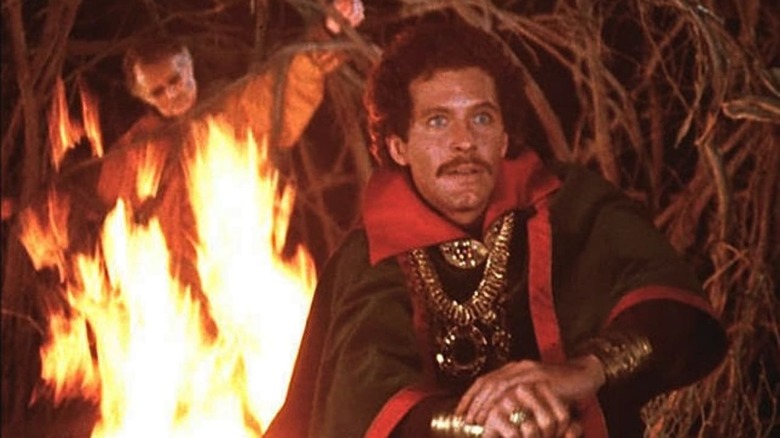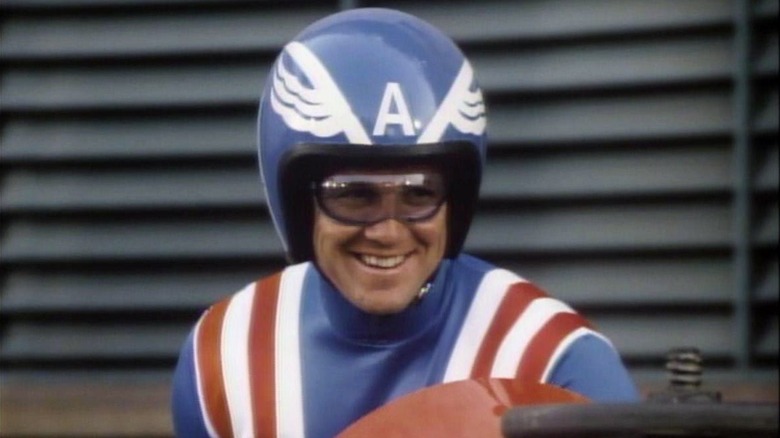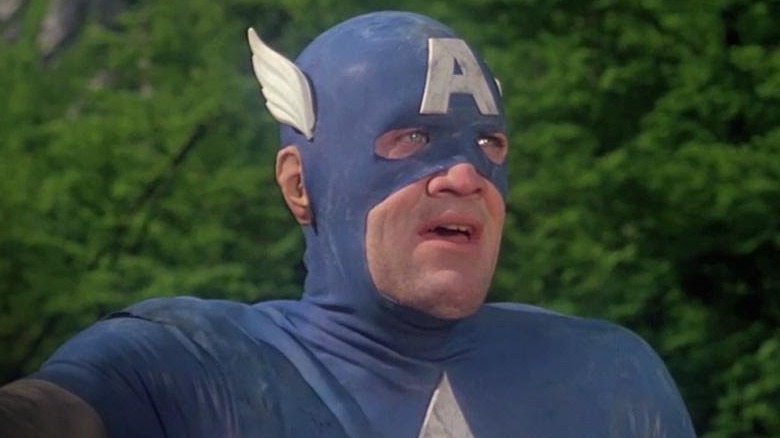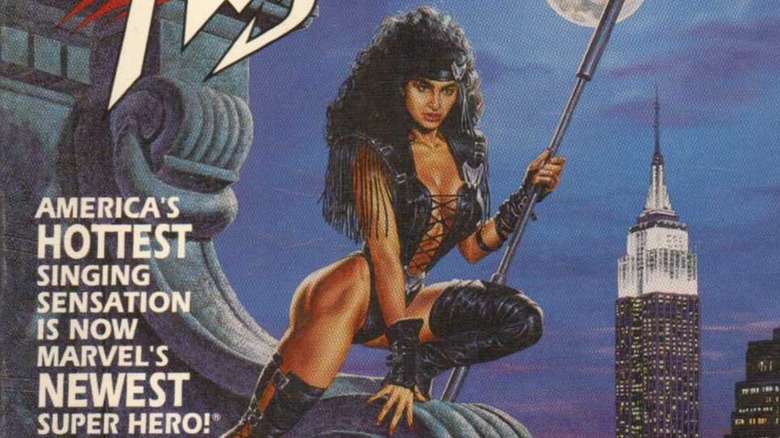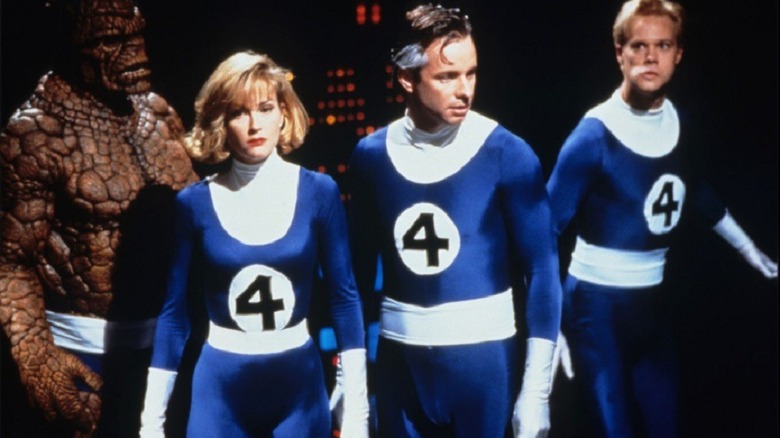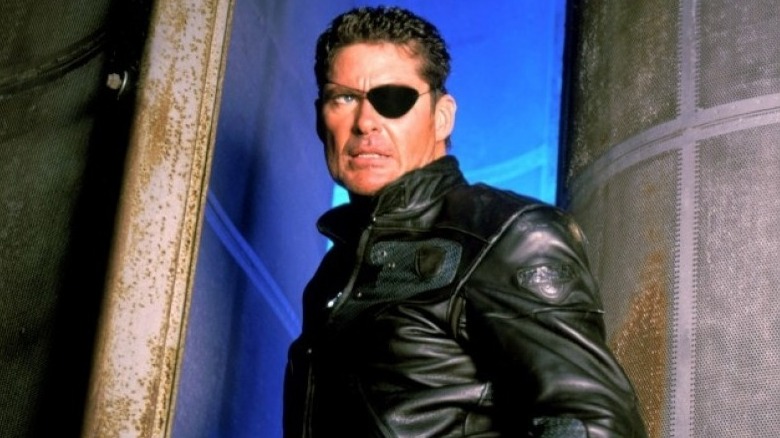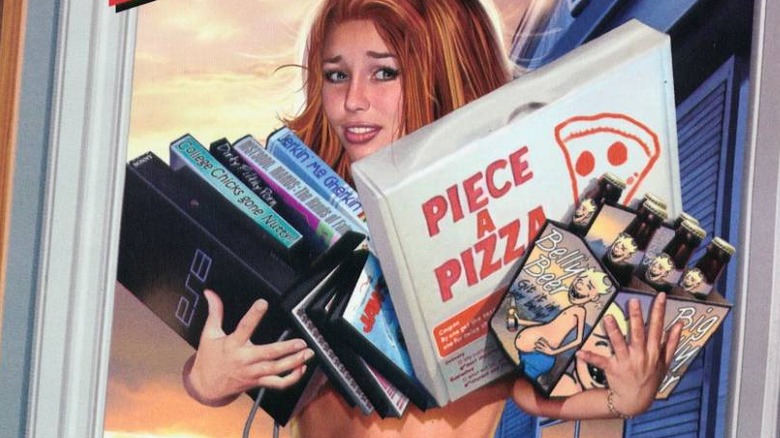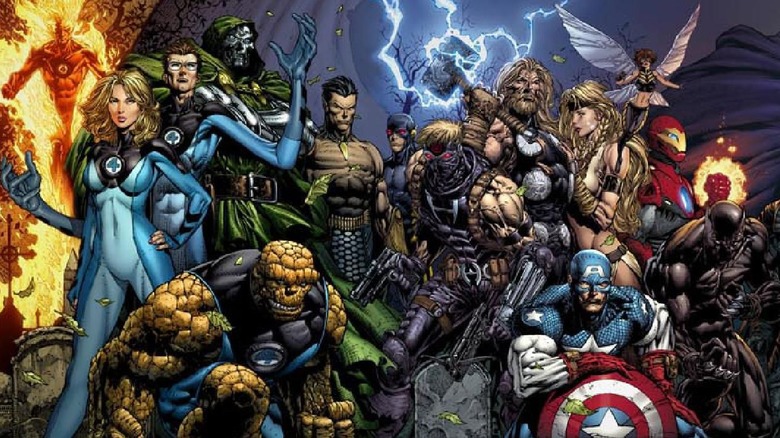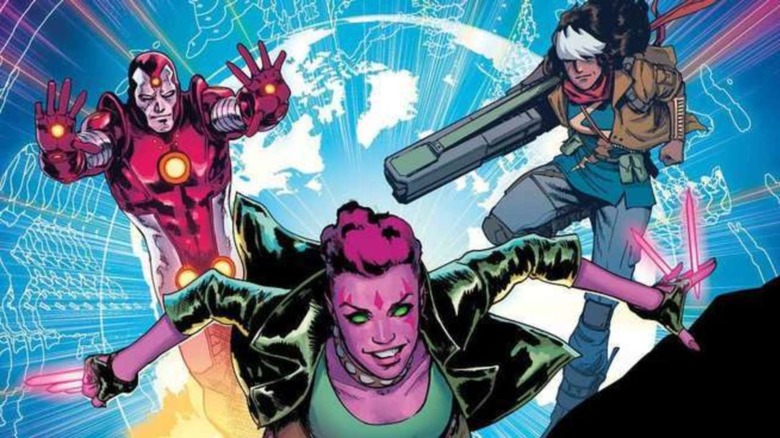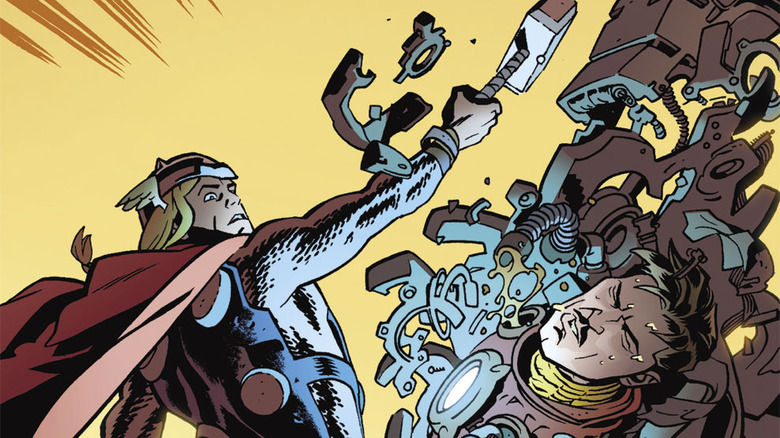Marvel's Biggest Forgotten Failures
Few companies in the entertainment world have been as successful as Marvel, first in comics and now in movies and TV. By now, Marvel is practically too big to fail. But that doesn't mean it succeeds at everything it tries. No one gets as big as Marvel has without taking big swings, and the bigger the swing, the bigger the miss.
Just as look at how Marvel Studios launched with "Iron Man" — hiring a star who'd seemingly torpedoed his career over a decade earlier, as a character no one but comic book nerds had heard of, setting up a comically ambitious network of expensive, interconnected franchises for a payoff years down the road. We've all seen how well that gamble worked out over the past decade. But Marvel's made plenty more gambles over the course of its existence, and not all of them have done nearly as well. Here are just a few of the most embarrassing failures we're sure Marvel wishes we'd all forget.
Dr. Strange could've only happened in the '70s
In 1978, Marvel was riding high off the success of the "Incredible Hulk" TV series starring Lou Ferrigno and Bill Bixby. The time seemed ripe for a Marvel TV universe, and in another world, the "Dr. Strange" pilot movie might've kicked one off.
But watching it now, it's easy to see why that never happened. The filmmakers seem to have looked at every element of Stan Lee and Steve Ditko's comics and thought, "How can we make this more boring?" Instead of going to a distant Himalayan sanctuary to learn the mystic arts, Dr. Strange meets up with some old guy right there in New York, getting out ahead of the 2016 movie's whitewashing controversy. And instead of the daughter of a flaming-headed extradimensional ruler, his love interest, Clea, is just a regular old college student.
Even if "Dr. Strange" had gone to series, it's hard to imagine anyone would still watch it today. Everyone here seems to be in a contest to see who can have the worst hair, and Dr. Strange wears more gold chains than Mr. T. The disco soundtrack, which uses an awful lot of what sounds like synthesized farts, hasn't aged any better. Neither have the "magic" effects, including one scene of Strange traveling to the astral plane that looks like it should've been projected on the wall of a hippie nightclub a decade earlier. Only one thing has aged well — that's future "Arrested Development"/"Archer" star Jessica Walter as the evil Morgan LeFay!
This Captain America has nothing in common with his comic book counterpart
Adapting a Marvel comic book seems like a can't-miss proposition. You've got the characters all laid out for you, a built-in audience, and decades' worth of stories that just need to be nudged into a different narrative format and stripped of the most expensive parts. But somehow, a lot of these productions seem to think what fans really love about comics is the names because that's about all that made it into the 1979 "Captain America" TV movie.
The hero's still a military vet named Steve Rogers, but that's about where the resemblance ends. Instead of doggedly trying to enlist to fight the fascists, he just wants to drive around and discover himself, even when he gets a gift-wrapped opportunity to become a bona fide superhero. And while we appreciate the difficulty for a flesh-and-blood actor pulling off the hero's over-the-top getup, it's hard to imagine a faithful adaptation looking any worse than the ridiculous Evel Knievel outfit Steve dons for the climax, replacing the classic mask with a gigantic motorcycle helmet. No wonder they kept it off-screen so long.
If you want any idea how seriously the filmmakers took the assignment, look no further than the origin they give for Captain America's moniker — as a sarcastic nickname for his father. It's hard to get viewers excited when the cast, especially Reb Brown as Cap, all sound so bored. And it ends with a climax so inert you may be worried the movie's going to keep on going.
God help Captain America
Marvel tried to make Captain America work again in 1990. And while the '70s TV movie drastically altered Cap's suit, this time, the project suffered from the opposite problem in the costume department. "I petitioned them over and over to let me adjust the Captain America costume," says director Albert Pyun, "but ... they were adamant it had to be the one in the comic." What looks good on the page doesn't look good on the screen and certainly not on a budget, and as a result, poor Cap was saddled with the wrinkly, rubbery mess seen here. And we're not quite sure what their excuse for the fake ears was.
Inside that suit is, of all people, Matt Salinger, son of the famously reclusive "Catcher in the Rye" author J.D. Salinger. The script doesn't do him any favors either, putting him in the role of a superhero who never actually seems to win a fight. He even loses his first time out in World War II when his enemy the Red Skull straps him to a missile aimed at the White House. Then again, Cap does manage to steer it to a harmless landing in the Arctic Ocean, which is pretty impressive, in that it makes no sense.
But "Captain America" was the work of Israeli-American super-schlockmaster Menahem Golan, so nonsense is par for the course. This was one of the first movies he made after the collapse of his Cannon Film Group. Given that this was how he chose to start his new venture at 21st Century Films, you can guess how long it lasted.
Nightcat tried to combine comics and music and failed
No, musical mutant Dazzler doesn't quite qualify for this list. All the big plans for a multimedia music star who'd appear live, in comics, and at the movies didn't quite pan out (trying to launch a disco star in 1980 couldn't have helped). But at least in the comics, Dazzler has become a cult favorite and a fixture of the X-Men. For a truly forgotten failure, you have to look exactly 10 years later when, against all reason, Marvel thought it'd be a good idea to try again.
The result was "Nightcat." This character at least managed to make it to a couple live appearances and an album, not that anyone seems to have bought it. As for the comic, it couldn't even make it to a second issue. But you can't fault Marvel for lack of trying — they tapped the one and only Stan Lee to write it. Then again, given that he was pushing 70 at the time, he probably wasn't the guy to launch a new youth-appeal character. And it's hard to imagine Nightcat's already ridiculous costume, ramped up to physics-defying levels of skin-baring by artists Joe Jusko and Denys Cowan, appealing to anybody but the terminally horny. Lyrics like, "Don't change, don't change / Stay that way / You're okay," probably didn't do "Nightcat" any favors either.
Fantastic Four failed so hard it was never officially released
The Fantastic Four may have started the Marvel Universe in the comics, but their luck in the movies hasn't been half as good. In the '90s, producer Bernd Eichinger was about to lose his rights to the characters, so he needed a quick, cheap movie to keep them from expiring, and he went to a man who knew quick and cheap — B-movie maestro Roger Corman. The crew didn't realize they'd signed on for a corporate write-off, though, and they took it all dead seriously. The documentary "Doomed" reveals they even snuck into the studio to cut the movie on their own time when the studio hung them out to dry.
Despite their efforts, this is an action movie so cheap that it goes an hour without an action sequence, and when we finally get one, it's just a "pow" sound effect and a spinning camera. The Human Torch appears as a sub-bowling alley CGI creation, and they couldn't even make Mr. Fantastic's graying temples look real. And it ends with a shot of his stretchy arm waving goodbye, looking less like a comic book brought to life than a car dealership blowup man. It never got an official release, but the joke's on Eichinger — he still lost the rights. However, most fans who managed to snag a bootleg copy agree that the subsequent "Fantastic Four" movies make it look pretty good!
Nick Fury: Agent of SHIELD is classic cable cheese
Before Samuel L. Jackson put on Nick Fury's eyepatch, that role belonged to "Baywatch" beefcake David Hasselhoff, who was still salty years later that he didn't get to reprise the role in the Marvel Cinematic Universe. He claims Stan Lee himself called him "the ultimate Nick Fury," but apparently, viewers disagreed since this feature-length pilot never got a series. That makes "Nick Fury: Agent of SHIELD" a deeply strange viewing experience since it opens with armed goons stealing the frozen body of HYDRA founder Baron von Strucker, which doesn't get thawed until the very end. Instead, the plot focuses on Strucker's daughter, who plans to overthrow the world's governments with the "Death's Head" virus and also a few nukes. This means SHIELD has to recruit their former director, who they find whaling away at a concrete wall in a mine shaft for reasons we may never understand.
There are also some hilarious special effects, including a Helicarrier that they somehow managed to make even more comic-booky than the comic book, supported on what look like table legs connected to skyscraper-sized jet engines. And then there's the robot dude who inexplicably lights up his eyes and wide-open mouth as a kind of living movie projector to deliver Strucker's message. What did the eventual movie Fury, Samuel L. Jackson, think of all this? To prepare for the role, he said (via ComicBook.com), "I watched David Hasselhoff ... and decided I was not going to do any of that."
Marville was a major mess
There's some context for "Marville," but it explains so little we won't waste your time. The first two issues are a broad superhero parody focused on Kal-AOL, a visitor from the future who tries to become a superhero — or something. It only makes sense if you've received the exact sequence of head injuries writer-editor Bill Jemas apparently suffered.
But with #3, it really goes off the deep end as what little plot we have disappears completely and the characters go on a journey to the dawn of time so Jemas can put his cranked-up theories about the origins of life in the mouth of God himself.
As if that wasn't self-important enough, #6 has Kal-AOL recap the series in the form of a sales pitch to an unseen editor, who agrees that Jemas' crackpot ideas could bring about world peace, but they won't sell because the sheeple just want to read about superheroes beating each other up. And then "Marville," like the world's worst party guest, refuses to leave. This six-issue miniseries goes on to a seventh issue, with submission guidelines for yet another forgotten failure, Jemas' short-lived revival of Epic Comics. Yes, the man who wrote "Marville" lectures you on good writing.
How do you sell a book like this? The covers don't even try, instead featuring allegedly sexy art by Greg Horn of a woman who never appears in the book, getting more and more naked as the sales got lower.
Trouble wasn't worth the trouble
The writing was on the wall for Marvel imprint Epic Comics when it launched with "Trouble." The idea was sound — American comics had largely ignored the female half of their audience since the romance genre went out in the '80s, so why not revive it for a new generation? But the execution was doomed from day one. To appeal to teen girls, editor Bill Jemas tapped "Kick-Ass"/"Civil War" writer Mark Millar, whose primary audience was the kind of edgy teen boys that teen girls normally avoid. Predictably, he went as over the top with the sex as he normally does with violence, leeringly chronicling the over-the-top sexcapades of teenagers named May, Ben, Mary, and Richard.
If those names sound familiar, well, there's the other problem. The series was heavily hinted to be a "Spider-Man" prequel, which means Marvel expected readers to get invested in the sex life of Spidey's Aunt May. Worse, the series introduced a major rewrite of the superhero's secret origins that writers and fans have wisely ignored ever since. May cheats on Ben with a whole lot of folks, including Richard — because that's what we wanted to see from comics' premier sweet little old lady! — and he and Mary end up raising little baby Peter as their own. That's right, Spider-Man's aunt is really his mother! This soap opera twist didn't help the series any, and it flopped so hard it took almost a decade before Marvel reprinted it.
Ultimatum is an unreadable gorefest
The Ultimate Universe was the farthest thing from a forgotten failure. But ten years into its existence, this new line of updated heroes wasn't new and up-to-date any more. The Ultimate line needed a shake-up, and it got one in Jeph Loeb and David Finch's "Ultimatum" miniseries. But instead of opening up new possibilities, the series closed off existing ones, killing off so many characters there were hardly any left to write about.
"Ultimatum" only begins to makes sense in light of the then-contemporary horror fad of "torture porn," as it appeared in 2009, because it's kinda like a superpowered "Saw." The thin plot — after his kids die, Magneto decides to eliminate humanity — is nothing but an excuse to kill character after character.
Some of their exits are insultingly offhanded. Others are so gory they're like a parody of "adult" comics. The Wasp gets eaten alive. Dr. Strange appears for all of two pages to fight a bad guy who has nothing to do with the main plot just so we can see the Sorcerer Supreme's head turn purple and explode. Even when the story seems to be over, Loeb adds an epilogue just so he can add Cyclops and Dr. Doom's deaths onto the pile. Fans weren't impressed. "Ultimatum" lost tens of thousands of readers by the end of its five-issue run.
Exiles could've been a classic
A cult classic with a cult too small to keep it in the red, fantasy author Saladin Ahmed's "Exiles" began in 2018 but ended within the year. Reviving the '90s team of multiverse-hopping heroes, Ahmed brought back teleporting X-Man Blink, along with Iron Lad from "Young Avengers." Plus, there was Wolvie, a cute little cartoon Wolverine from a cute little cartoon world who's about as different from the classic character as you can imagine, as well as Khan, a bitter, scarred Ms. Marvel from a dystopian future. On top of all that, we were treated to a Valkyrie based on Tessa Thompson's character in "Thor: Ragnarok."
The worlds these characters hopped back and forth from showed just as much inventiveness, including one that combined the Marvel Universe with the "Thousand and One Nights" and another full of superpowered pirates. And Ahmed's ideas became even more spectacular thanks to the lush artwork and inventive page designs from Javier Rodriguez. The two of them seemed to have enough ideas to keep the book going forever, but sadly, that wasn't meant to be.
Fortunately, Marvel still knew good talent when they had it. Rodriguez bounced back into the Inhumans series "Royals" before becoming enough of a star to get a shot at reinterpreting Marvel's biggest stories in the spectacular "History of the Marvel Universe." Ahmed's comics career has only gone up too. As of this writing, he's got two of Marvel's biggest heroes on his plate with "Miles Morales: Spider-Man" and "Magnificent Ms. Marvel."
Thor: The Mighty Avenger was worthy of more success
Not every failure is deserved. Plenty of Marvel series have come and gone without ever selling enough to sustain themselves, no matter how cleverly written or beautifully drawn they were. That was the fate of "Thor: The Mighty Avenger." The series brought in writer Roger Langridge, hot off the cult success of "Fred the Clown" and "The Muppet Show Comic Book," to create new adventures for Thor without all the baggage of his decades of continuity. He came back with an origin story focusing on Thor's struggle to return to Asgard and his romance with Jane Foster. Chris Samnee took on art duties, creating expressive characters and inventive designs for new versions of classic Marvel characters.
But even the hype of Marvel's first "Thor" movie wasn't enough to keep the book afloat. It ended after less than a year, and the final issue suggests the creative team had little notice since it concludes without answering the central questions of why Thor's been exiled from Asgard and what role Loki played.
It wasn't a total loss though. The series got enough attention in the right places to make Samnee Marvel's hot new artist, leading to a classic run on "Daredevil" with writer Mark Waid, who'd team up with him again on "Captain America" and "Black Widow." The outlook was less rosy for Langridge, who never worked for Marvel again, though he's continued turning out classic work elsewhere, including the "Alice in Wonderland"-based "Snarked!" and a stunning take on "Popeye."
